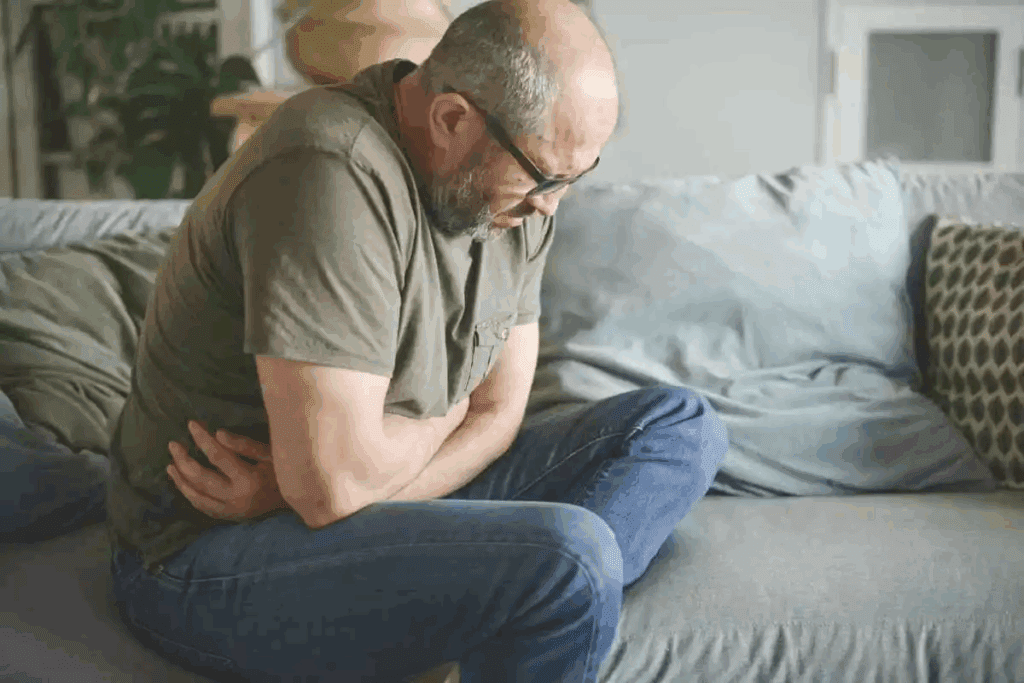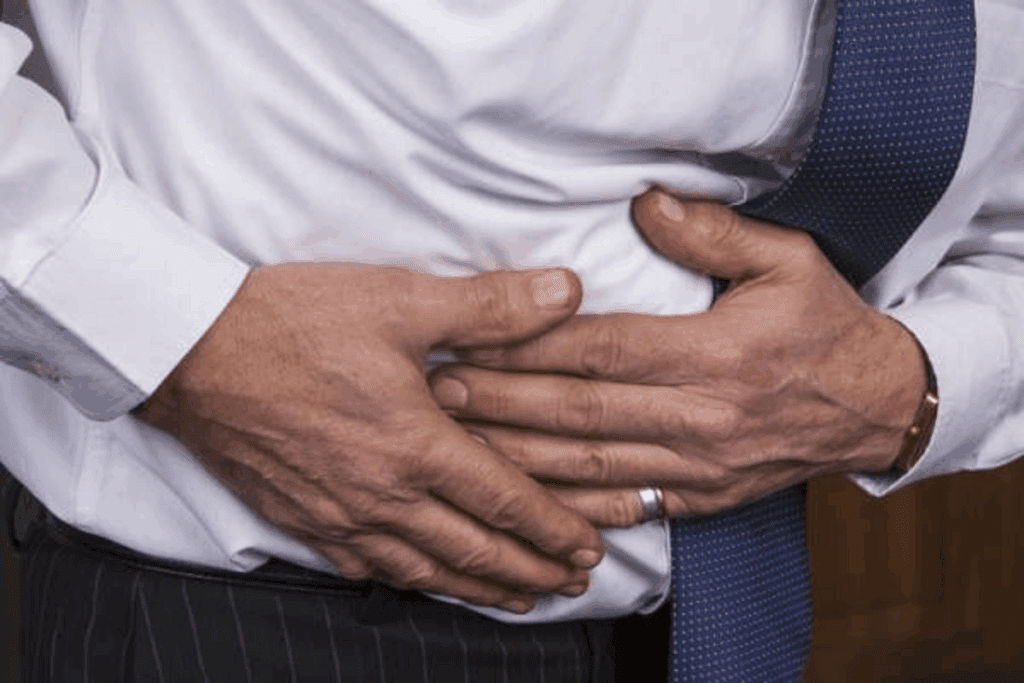Last Updated on November 26, 2025 by Bilal Hasdemir

A common bile duct stone is a critical danger. Get 10 essential facts on diagnosis, management, and life-threatening complications.
Gallstones are solid deposits that form in the gallbladder or biliary tree. They are mainly made of cholesterol, bilirubin, and bile, as StatPearls explains.
These stones can block bile flow, causing severe health problems. Getting a diagnosis and treatment quickly is very important.
It’s key for healthcare providers and patients to know about choledocholithiasis. This knowledge helps ensure the best care and outcomes.

Gallstones in the common bile duct, or choledocholithiasis, block bile flow. The American Society for Gastrointestinal Endoscopy (ASGE) says managing this condition needs a detailed plan.
Choledocholithiasis means having gallstones in the common bile duct. It comes from Greek words for “bile duct” and “stone formation.” This issue can be asymptomatic or cause severe symptoms like jaundice, abdominal pain, and cholangitis.
Key terms related to choledocholithiasis include:
The common bile duct is key for digestion, carrying bile from the liver and gallbladder to the small intestine. Stones here can block bile flow, causing problems. The duct’s location makes it prone to blockage by gallstones.
Choledocholithiasis is serious because it can lead to:

The global burden of choledocholithiasis can be better understood through its epidemiology. This shows us how common it is and who is at risk. Choledocholithiasis is a serious condition that can complicate gallstone disease.
About 10–15% of people with gallstones also have choledocholithiasis. The risk of gallstones, and then choledocholithiasis, goes up with age. The NCBI Bookshelf says certain groups are more at risk due to genetics, diet, and lifestyle.
Choledocholithiasis’s prevalence varies by population. In Western countries, it’s more common because of higher gallstone rates.
| Population | Prevalence of Choledocholithiasis |
| Western Countries | Higher incidence due to gallstones |
| Asian Populations | Varied, often related to dietary and genetic factors |
Knowing who is at risk for choledocholithiasis is key. Age is a big factor, as gallstones and choledocholithiasis become more common with age.
Other risk factors include:
Knowing these risk factors helps in early detection and management of choledocholithiasis. Healthcare providers can take steps to prevent it and watch those at higher risk.
Choledocholithiasis is when stones block the common bile duct. This happens due to several reasons. The stones can move from the gallbladder and their makeup also plays a role.
Common bile duct stones can be either primary or secondary. Primary stones form in the bile ducts, often due to bile stasis or infection. On the other hand, secondary stones come from the gallbladder.
Most common bile duct stones are secondary, coming from the gallbladder. Their journey into the bile duct is influenced by their size and the biliary system’s anatomy.
The movement of stones from the gallbladder to the common bile duct is key. Several factors help this process:
Larger stones are more likely to block and move into the common bile duct.
The types of common bile duct stones vary. In Western populations, cholesterol stones are the most common. There are also pigment stones, linked to hemolysis or biliary infection, and mixed stones, which are a mix of cholesterol and pigment.
Knowing what the stones are made of helps doctors understand the cause and decide on treatment.
“The composition of gallstones can provide valuable insights into the underlying pathophysiological processes and guide therapeutic strategies.”
In summary, the formation of common bile duct stones is complex. It involves stone migration, composition, and other factors. Understanding these is key for proper diagnosis and treatment.
Symptoms of choledocholithiasis vary widely. They can range from the classic triad to unusual signs. It’s key for doctors to know about these different symptoms.
The classic symptoms include jaundice, right upper quadrant pain, and fever. These signs point to a serious blockage and possible infection in the bile duct.
Jaundice makes the skin and eyes turn yellow because of blocked bile flow. Pain in the right upper quadrant comes from the bile duct swelling or inflammation. Fever shows there’s an infection, like ascending cholangitis.
Not everyone shows the classic symptoms. Many have atypical symptoms like vague pain, nausea, vomiting, or changes in stool or urine color. Some might not show any symptoms at all.
Atypical symptoms make diagnosis tough. Doctors need to be careful and look at patient risk factors and lab results closely.
Sometimes, choledocholithiasis is found by accident during tests for other issues. These “silent stones” might not cause symptoms right away but can lead to problems if not treated.
Finding silent stones shows how important it is to check thoroughly and plan for treatment to avoid future issues.
Laboratory tests are key in finding choledocholithiasis. They check liver function and look for any problems. Doctors use both clinical checks and lab tests to diagnose choledocholithiasis.
Liver function tests (LFTs) are very important. High levels of alanine transaminase (ALT) and aspartate transaminase (AST) show liver damage or blockage in the bile ducts.
Bilirubin levels are also a big clue. High conjugated (direct) bilirubin means there’s a blockage in the bile ducts. The way bilirubin goes up can tell doctors more about the blockage.
Pancreatic enzymes like amylase and lipase can also be high. This happens if a stone blocks the pancreatic duct. High levels can mean pancreatitis, a serious problem.
Markers like C-reactive protein (CRP) and white blood cell count (WBC) can go up too. This is true if there’s cholangitis or pancreatitis with choledocholithiasis.
| Laboratory Test | Typical Findings in Choledocholithiasis |
| Liver Function Tests (LFTs) | Elevated ALT, AST, ALP, and GGT |
| Bilirubin Levels | Elevated conjugated (direct) bilirubin |
| Pancreatic Enzymes | Elevated amylase and lipase |
| Inflammatory Markers | Elevated CRP and WBC |
Many imaging methods help diagnose choledocholithiasis. These tools are key in spotting common bile duct stones. They also guide treatment plans.
Ultrasonography is often the first choice because it’s easy and available everywhere. It can show if the bile duct is swollen and sometimes see stones. But, its ability to find stones depends on the skill of the person doing the scan and the patient’s body type.
CT scans are better than ultrasonography at finding bile duct stones. They can also spot problems like pancreatitis or cholangitis. Using contrast helps see the biliary system better.
MRCP is very good at finding choledocholithiasis without needing contrast. It shows the biliary system clearly. This makes it great for people with kidney problems.
EUS is useful when other tests don’t work. It gives clear pictures of the bile duct and nearby areas. It can also take tissue samples for tests.
| Imaging Technique | Sensitivity | Specificity | Advantages |
| Transabdominal Ultrasonography | Moderate | High | Non-invasive, widely available |
| CT Scanning | High | High | Detects complications, widely available |
| MRCP | Very High | Very High | Non-invasive, detailed biliary imaging |
| EUS | High | High | High resolution, can be combined with FNA |
The right imaging method depends on many things. These include where the stones are, how big they are, and the patient’s health. Studies show MRCP is very good at confirming CBD stones. It’s a key tool in medical care.
Diagnosing choledocholithiasis needs a detailed look at other possible biliary and pancreatic issues. Doctors follow guidelines to think about other conditions when they suspect choledocholithiasis.
Conditions like biliary strictures, sclerosing cholangitis, and biliary dyskinesia can look similar to choledocholithiasis. They share symptoms like jaundice and pain in the belly. So, it’s important to figure out the exact cause.
Pancreatitis and tumors in the pancreas are also part of the differential diagnosis. The pancreas and bile duct are close together. Problems in one can affect the other, making diagnosis harder.
Hepatitis and cirrhosis are also important to consider. Liver problems can change liver function tests. These tests are key in diagnosing choledocholithiasis.
Clinical decision algorithms and guidelines help doctors make a diagnosis. They use patient symptoms, lab results, and imaging to decide between possible causes.
By looking at all these possibilities, doctors can give the right treatment to patients quickly.
Managing choledocholithiasis needs a detailed plan. This plan includes endoscopic, surgical, and percutaneous methods. The right treatment depends on the patient’s condition, the stone’s type, and the doctor’s skills.
ERCP is key in treating common bile duct stones. It’s both a diagnostic and treatment tool, allowing for direct stone removal. ERCP is recommended for patients with confirmed choledocholithiasis, like those with jaundice or cholangitis. The process involves entering the bile duct, then removing stones with balloons or baskets.
For those who can’t or won’t have endoscopic treatment, surgery is an option. Laparoscopic common bile duct exploration is a good choice, allowing for stone removal and cholecystectomy if needed. Open surgery is for very complex cases or when less invasive methods can’t be used.
PTC is another way to manage choledocholithiasis, mainly for those who failed ERCP or have unusual anatomy. It accesses the biliary system through the skin, removing stones or providing drainage. PTC is often paired with other treatments to ensure all stones are removed.
After treatment, patients need close watch for complications like bleeding, pancreatitis, or cholangitis. Post-procedure care includes monitoring liver function tests and symptoms. Follow-up imaging might be needed to check if all stones are gone and if new ones appear.
Dealing with choledocholithiasis is complex and needs a team effort. Knowing all the treatment options helps doctors tailor care for each patient. This approach improves outcomes and reduces risks.
Antimicrobial therapy is key in treating choledocholithiasis, mainly when cholangitis is involved. Stones in the common bile duct can cause bacterial growth and infection. This makes antibiotics necessary.
Antibiotics are needed for patients with choledocholithiasis showing signs of infection or cholangitis. Symptoms include fever, jaundice, and abdominal pain. The decision to start antibiotics should be based on symptoms and lab results.
The choice of antibiotics depends on the bacteria involved and local resistance patterns. Common antibiotics for biliary infections are:
| Antibiotic | Dose | Frequency |
| Piperacillin-tazobactam | 4.5 g | Every 8 hours |
| Ciprofloxacin | 400 mg | Every 12 hours |
| Metronidazole | 500 mg | Every 8 hours |
The length of antibiotic treatment depends on the infection’s severity and how the patient responds. Treatment usually continues until symptoms improve and lab results return to normal. It’s important to watch for any changes in the patient’s condition.
Antibiotic treatment should be based on local resistance patterns to be effective. The rise of resistant bacteria makes managing choledocholithiasis challenging. Using antibiotics wisely and following guidelines is vital.
In summary, antimicrobial therapy is essential in managing choledocholithiasis, mainly when there’s an infection. Understanding when to use antibiotics, choosing the right ones, and being aware of resistance helps healthcare providers improve patient care.
Untreated bile duct stones can cause serious problems. These stones can block the bile duct. This blockage can lead to severe health issues if not treated quickly.
Acute ascending cholangitis is a serious infection of the bile duct. It happens when bacteria move up from the intestine into the bile duct. This is often due to blockage by stones.
Symptoms include fever, jaundice, and abdominal pain, known as Charcot’s triad. If not treated, it can become suppurative cholangitis, which is much more dangerous.
Acute biliary pancreatitis happens when a stone blocks the pancreatic duct. This can cause pancreatitis, which can be mild or very serious. The pancreas gets inflamed, and in severe cases, it can even die.
Long-term blockage of the bile duct can cause secondary biliary cirrhosis. This happens when bile builds up in the liver, damaging it. Over time, it can lead to cirrhosis, where the liver becomes scarred and can’t function well.
Gallstone ileus is a rare but serious problem. It occurs when a large gallstone moves through a fistula and gets stuck in the intestine. This is more common in older people and needs immediate surgery.
In summary, untreated bile duct stones can lead to severe and dangerous complications. It’s important to diagnose and treat them early to prevent these problems and improve patient care.
Managing choledocholithiasis requires both medical and lifestyle changes. It’s key to prevent it from coming back to improve health and avoid complications.
Experts say cholecystectomy is best to stop choledocholithiasis from happening again. Cholecystectomy removes the gallbladder, which stops bile duct stones. Studies show it greatly lowers the chance of stones coming back.
“Removing the gallbladder stops stones from forming again,” a study on managing choledocholithiasis found.
Ursodeoxycholic acid (UDCA) therapy also helps prevent bile duct stones. UDCA makes bile less likely to form cholesterol stones. It’s considered for those who can’t have cholecystectomy right away.
Changing your lifestyle is key in managing choledocholithiasis long-term. Eating right, staying hydrated, and keeping a healthy weight are important. Dietary changes like eating less fat and more fiber can also help.
Regular check-ups are vital for those who’ve had choledocholithiasis. These include imaging and liver tests to watch for signs of problems. Early detection means quicker treatment, which helps patients.
In summary, preventing choledocholithiasis recurrence needs a mix of treatments and lifestyle changes. With cholecystectomy, UDCA, diet, and regular check-ups, patients can lower their risk of future problems.
Managing choledocholithiasis well means knowing how to diagnose and treat it. The American Society for Gastrointestinal Endoscopy (ASGE) has guidelines to help doctors. These guidelines are key for handling the challenges of choledocholithiasis.
Handling choledocholithiasis involves several steps. These include using endoscopes, surgery, and antibiotics. It’s important to know when to use each method to get the best results for patients.
By using a complete approach to treating choledocholithiasis, doctors can lower the chance of serious problems. This includes avoiding infections and liver damage. The ASGE guidelines help doctors give the best care to those with choledocholithiasis.
Choledocholithiasis is when stones block the common bile duct. This can cause serious problems like cholangitis or pancreatitis.
Symptoms include jaundice, pain in the right upper quadrant, and fever. Some people might not show these signs or have different symptoms.
Doctors use tests like liver function tests and imaging like ultrasonography and CT scans to diagnose it.
Treatment options include ERCP, surgery like cholecystectomy, and sometimes PTC.
Antibiotics are used to fight infections like cholangitis. The choice of antibiotic depends on the infection’s severity and local resistance.
Untreated, it can cause serious issues like cholangitis, pancreatitis, cirrhosis, and gallstone ileus.
Preventive measures include removing the gallbladder, using ursodeoxycholic acid, and making lifestyle changes to avoid gallstones.
ERCP is key for diagnosing and treating choledocholithiasis. It allows for stone removal and unclogging the duct.
Yes, it can come back. To lower the risk, removing the gallbladder and regular follow-ups are recommended.
Risk factors include gallstones, certain demographics, and conditions affecting the biliary system.
Subscribe to our e-newsletter to stay informed about the latest innovations in the world of health and exclusive offers!